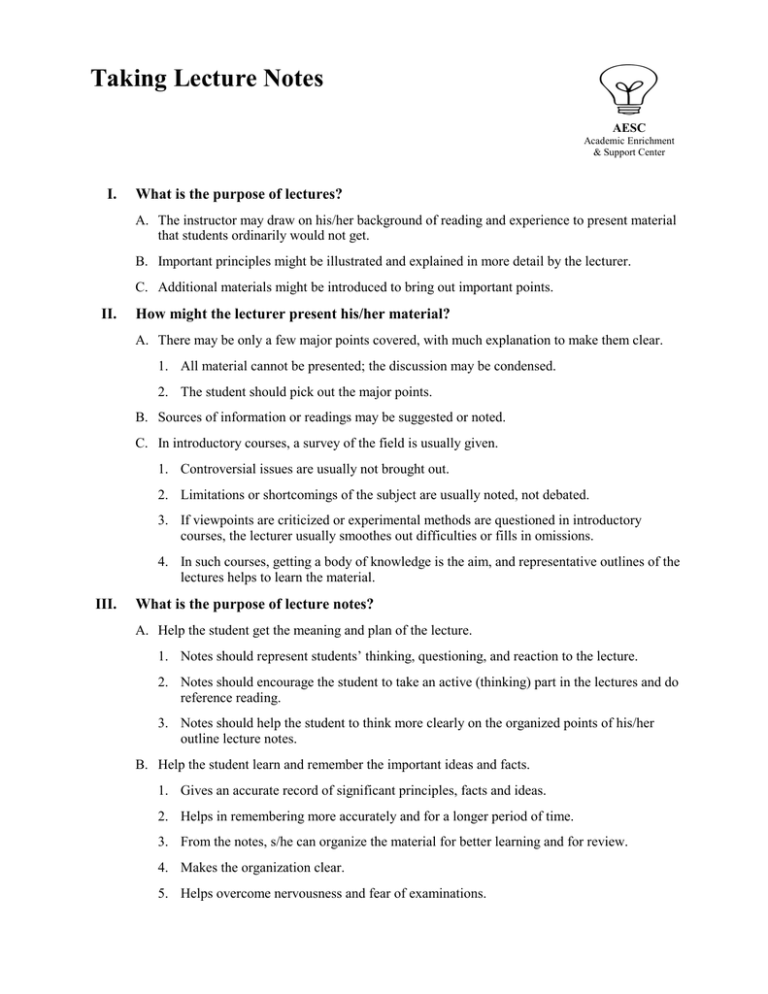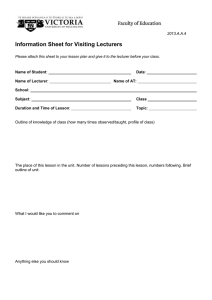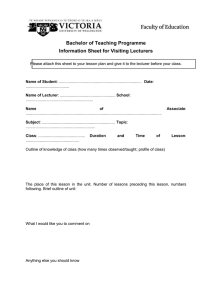Taking Lecture Notes
advertisement

Taking Lecture Notes AESC Academic Enrichment & Support Center I. What is the purpose of lectures? A. The instructor may draw on his/her background of reading and experience to present material that students ordinarily would not get. B. Important principles might be illustrated and explained in more detail by the lecturer. C. Additional materials might be introduced to bring out important points. II. How might the lecturer present his/her material? A. There may be only a few major points covered, with much explanation to make them clear. 1. All material cannot be presented; the discussion may be condensed. 2. The student should pick out the major points. B. Sources of information or readings may be suggested or noted. C. In introductory courses, a survey of the field is usually given. 1. Controversial issues are usually not brought out. 2. Limitations or shortcomings of the subject are usually noted, not debated. 3. If viewpoints are criticized or experimental methods are questioned in introductory courses, the lecturer usually smoothes out difficulties or fills in omissions. 4. In such courses, getting a body of knowledge is the aim, and representative outlines of the lectures helps to learn the material. III. What is the purpose of lecture notes? A. Help the student get the meaning and plan of the lecture. 1. Notes should represent students’ thinking, questioning, and reaction to the lecture. 2. Notes should encourage the student to take an active (thinking) part in the lectures and do reference reading. 3. Notes should help the student to think more clearly on the organized points of his/her outline lecture notes. B. Help the student learn and remember the important ideas and facts. 1. Gives an accurate record of significant principles, facts and ideas. 2. Helps in remembering more accurately and for a longer period of time. 3. From the notes, s/he can organize the material for better learning and for review. 4. Makes the organization clear. 5. Helps overcome nervousness and fear of examinations. 6. Makes cramming or going over a great mass of unlearned material at the close of the course unnecessary. IV. What are some suggestions for taking lecture notes? A. Study the topic before the lecture. 1. Follow the syllabus or course outline. a. If none, follow the text if the lecturer does; or b. Try to follow the lecturer’s topic. 2. The daily study should be: a. Review of yesterday’s notes; b. Study of today’s lesson (text or readings); c. Survey or preview the text lesson or topic, by noting main topics or headings, subheadings, charts, tables, illustrations, etc., and reading the summary if there is one in the text. B. Be ready to write when the lecture begins. 1. Concentrate on what is being said 2. Do more listening and less writing 3. Look for cues to main points (titles, topic sentences, transition, expressions, repetitions, voice inflections, gestures, and summaries). 4. If the lecture is not well organized, put down all main points and reorganize later 5. If a point is missed, get it later from another student or from the instructor 6. Follow the form given for laboratory notes C. Have a system for taking notes. 1. Outline form is usually best, except for some science courses such as physics or mathematics 2. Notes should be brief but should show relationships of points to one another. a. Make notes in own words. b. Condense thoughts to a few words. c. Use abbreviations but not shorthand. d. Write questions you think of. e. Leave blanks for filling in later. f. Omit anecdotes and detailed illustrations. g. Copy important names, dates, and formulas carefully. h. Place own reactions in brackets so as not to confuse them with lecturer’s viewpoints. 3. Reorganize notes as soon as possible after the lecture. 4. Some students divide the notebook page in one of two ways: a. Lecture notes on left half, reading notes on right; b. Lecture notes on left half, revised lecture notes on right. From: The Learning and Academic Skills Center, University of Minnesota

